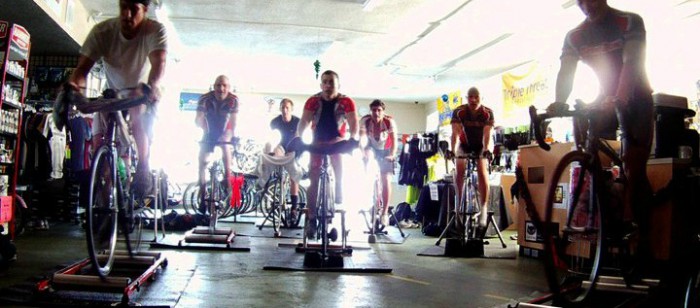
I love my bike rollers and I have been known to ride the rollers on rainy summer days in order to avoid the extra work of having to wash bikes. That said I am glad that my job requires that I travel to warmer climates a couple of times over the winter and have a break from the daily garage roller derby. As the days shorten and the weather gets colder rollers, trainers and (hopefully) outdoor rides all have a place in our training schedule during the coming months. What I hope to do with this brief article is to help readers break up the monotony of winter training while helping to maintain the quality of on-the-bike training since this is the time of year that races are won, upgrade points are scored and goals are met.
- Early morning dual rides: If you’re one of those athletes that like to get your workouts in early in the day, a later sunrise doesn’t necessarily mean having to do your entire workout indoors. Scheduling your ride to start 15 – 30 minutes prior to a safe amount light to ride outside is perfect timing. Prep your bike, clothing, bottles and rollers the night before, and then set up the rollers on the porch or just inside the open garage door for the first part of your morning ride. Getting your early morning workout started on the rollers this way will allow you to be fully dressed to ride outside (without overheating), and get a quality warm up that wakes up and engages not just your legs and cardiovascular system but also your core and neuromuscular system (See Coach Greg Mueller’s earlier post on this blog for more detail) . This will help you get the most quality out of the remainder of your ride.
- Reverse Option #1 from above if you prefer to ride in the late afternoon or evening. Start your ride outside and get your quality work done in the late day sun. Then arrive home for you cool down on the rollers. To double up on the effectiveness of your roller cool down, have a bottle of recovery drink ready to go and sip that while you spin your legs out.
- When you are stuck inside different training sessions may require different training tools. For skill work, neuromuscular training, aerobic efforts and even lactate threshold work (make sure that you work up to this skill level) rollers are great. However, if your training calls for high end time trial efforts or VO2 max intervals (basically any type of interval where you are crossed and breathing through your ears upon finishing), these are best done on a trainer or rollers with a fork mount to ensure both safety and quality.
- If you are really motivated and have enough equipment, performing your warm up for your high end efforts mentioned in point number 3, on the rollers has the potential to produce better results. Just as I mentioned in point number 1, you’ll be hitting the high quality portion of your workout with all the physical tools of your body ready to perform at a high level.
- Stay focused on being a cycling athlete by watching and listening to the right things. Instead of dissociating with what is going on by watching movies or listening to music, stay connected to what you are doing watch sport specific footage (bike races or triathlon) and keep the music volume low enough to hear yourself breathing. Dr. Robert Chapman at the University of Indiana is finding that while athletes who dissociate through music have lower perceived exertion, athletes who can hear themselves breathing appear to be better at pacing their efforts consistently.
Mike Durner
National Team Coach
U.S. Paralympic Cycling

Add new comment